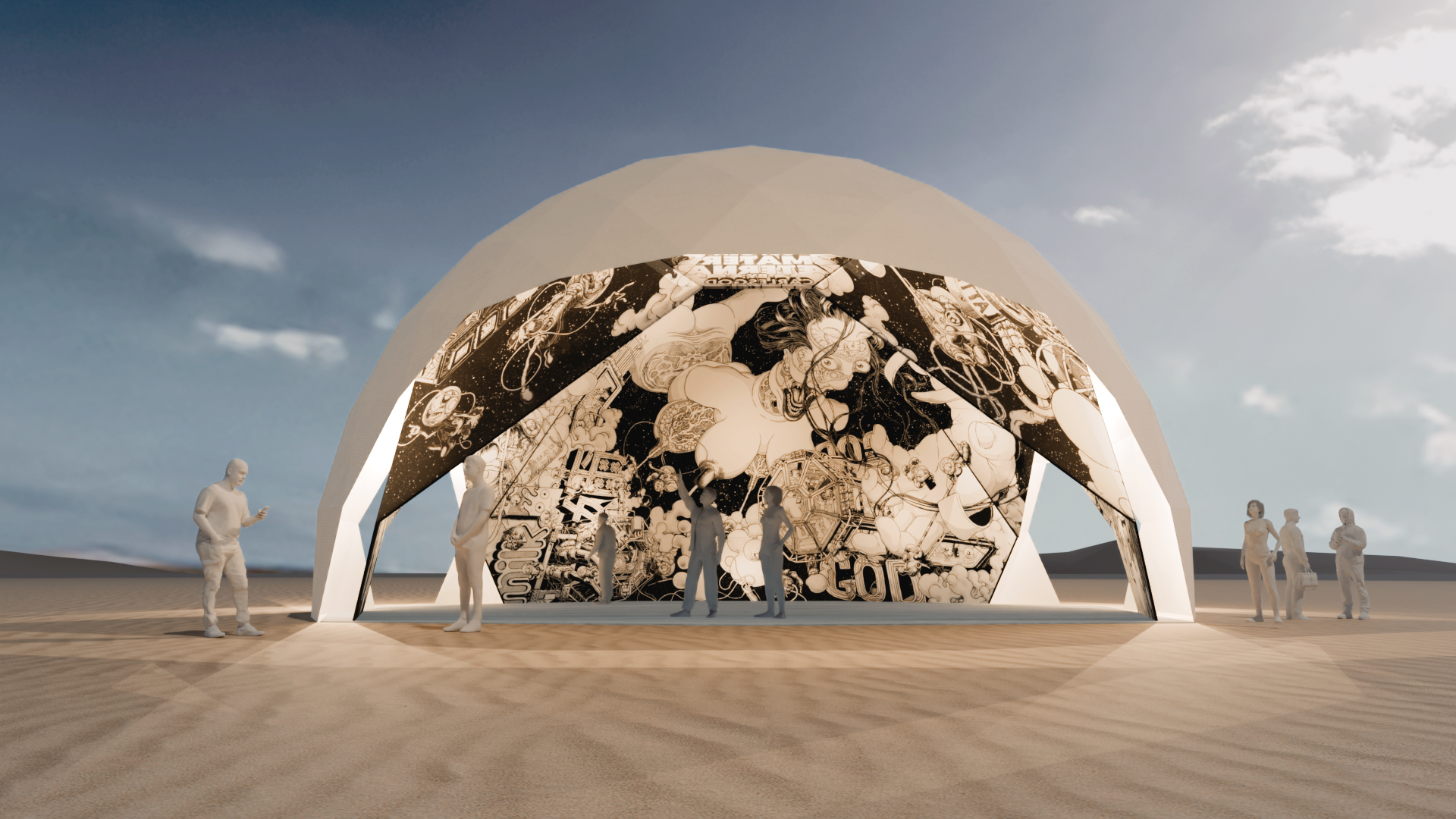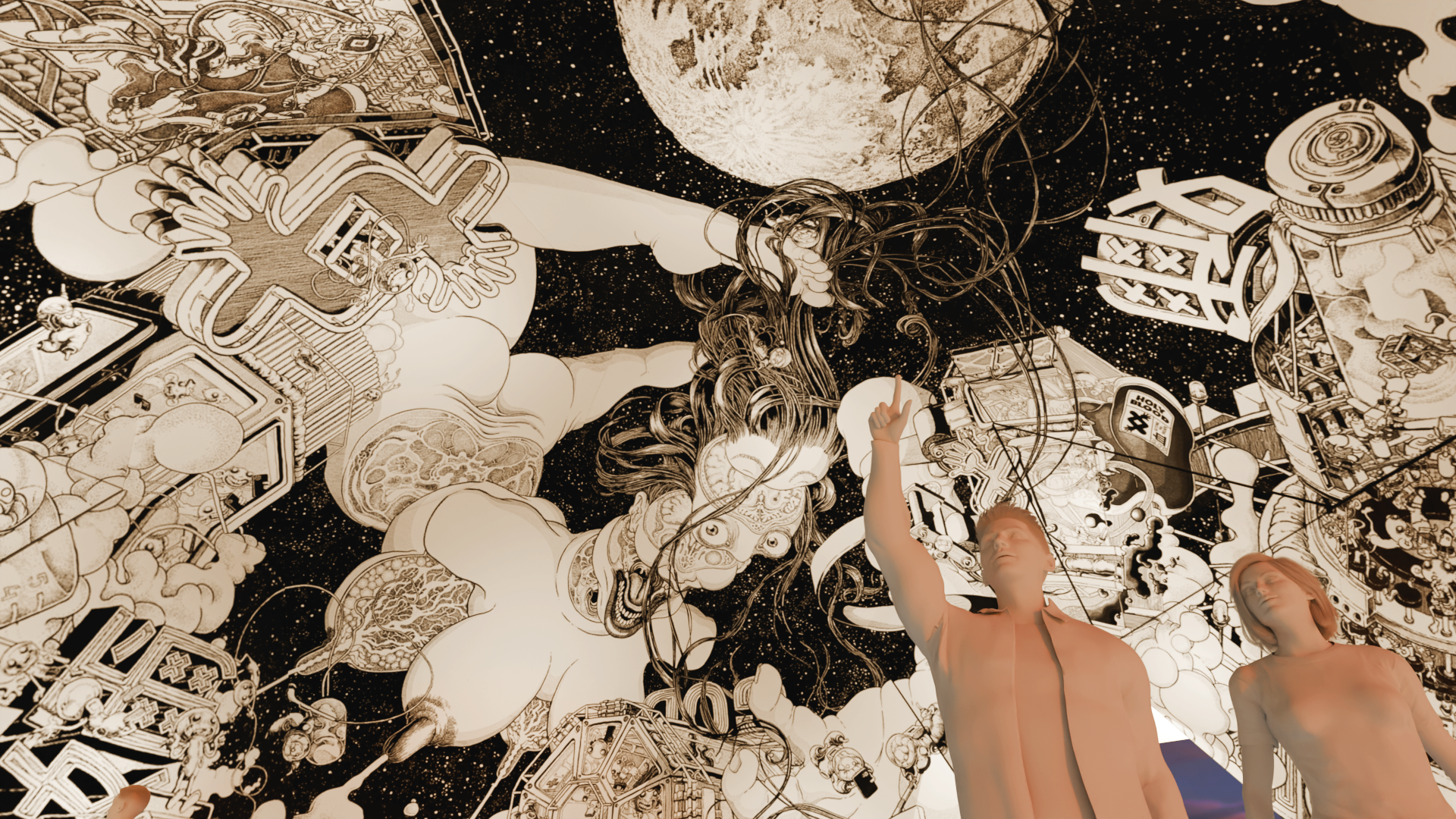Mallorcan artist Carles García O'Dowd unveils a monumental illustrated dome at Burning Man 2025
August 25–31, 2025 — Visit at Metal Mimi Camp, located at 6:30 & C in Black Rock City, Nevada.
Mockup by Gregory Guy
Black Rock City, Nevada (USA) — In the vast expanse of Nevada's playa, where temporary cities rise from dust and imagination, Carles García O'Dowd has erected a cathedral of contemporary myth-making. Cupola: Mater Aeterna, the Spanish-Irish artist's most ambitious work to date, transforms the ancient tradition of narrative murals into a living, breathing sanctuary of light and story.
The installation materializes as a 36-foot geodesic dome, its surface composed of 22 meticulously crafted fabric panels that glow from within through a sophisticated LED system. Each panel represents months of labor in García O'Dowd's Oaxacan studio, where traditional craftsmanship meets speculative vision. The structure itself pays homage to Buckminster Fuller's utopian geometries while subverting their techno-optimist promise into something more complex and urgent.
García O'Dowd has long been recognized for his synthesis of graphic storytelling and performative practice, and Mater Aeterna represents the culmination of this approach. The work springs from three conceptual wellsprings that define our contemporary moment: the mythologies we construct to navigate an increasingly fragmented world; the reality of ecological collapse and our fantasies of planetary escape; and the speculative fiction tradition that offers both warning and possibility. Drawing particularly from the works of Ursula K. Le Guin and Kim Stanley Robinson, García O'Dowd positions his dome as both observatory and oracle.
The project's genesis lies in the artist's pandemic-era mural (M)other, but Cupola expands this exploration into fully immersive territory. Visitors enter a world populated by García O'Dowd's distinctive cosmology: the Yoyos, grotesque embodiments of Northern consumerism and self-absorption, and the Topoids, spectral figures representing the invisible laborers, migrants, and dispossessed who sustain our global systems. These archetypes move through landscapes that blur the boundaries between digital alienation and natural devastation, creating a visual mythology for our fractured times.
The dome's visual language draws explicitly from the graphic traditions of Japanese science fiction manga, particularly the works of Katsuhiro Otomo, Masamune Shirow, Hideaki Anno, and Hayao Miyazaki. Like these masters of speculative illustration, García O'Dowd understands how to make the cosmic personal and the personal political. Each panel was hand-drawn in ink before being translated into the dome's architectural framework, preserving the intimacy of mark-making within a monumental scale.
Photograph by Yura Makarov
At the installation's heart lies a haunting central image: a colossal feminine figure reaches toward the viewer while being systematically dismembered by swarms of smaller beings. This vision channels ancient understandings of Earth as living mother—a fertile, nurturing body upon which all life depends. The image resurrects animist and matriarchal mythologies that understood the feminine principle as tied to cycles, fertility, and collective belonging, offering a stark counterpoint to extractive, patriarchal paradigms of endless growth.
The dome's title carries multiple resonances. Cupola references both the sacred architectural tradition of painted domes—from the Sistine Chapel to countless Orthodox churches—and the observation module of the International Space Station, from which astronauts contemplate Earth's fragile totality. Mater Aeterna invokes the eternal mother, the archetypal feminine that transcends individual mortality to embody continuity and regeneration.
García O'Dowd's installation operates through what he calls "activated muralism"—visual storytelling that comes alive through oral narration and spatial immersion. Following traditions that stretch from Paleolithic cave paintings to Renaissance frescoes, the work requires no text to communicate its narrative. Instead, it invites viewers into a communal experience where story unfolds through movement, contemplation, and shared presence.
In an era when virtual reality promises to transport us beyond material constraints, Cupola: Mater Aeterna insists on the power of physical gathering and analog craft. The work proposes that our most urgent need is not technological transcendence but rather a fundamental reimagining of how we inhabit the planet, deploy technology, and conceive collective futures beyond the mythology of infinite growth.
As participants in Burning Man's temporary autonomous zone gather beneath García O'Dowd's illuminated dome, they encounter more than an art installation—they enter a space of possibility where ancient wisdom and speculative futures converge. In the desert's vastness, surrounded by the festival's creative chaos, Cupola: Mater Aeterna offers a moment of contemplation and communion, inviting visitors to consider what myths we need to survive the futures we're creating.
For García O'Dowd, whose practice has always balanced the intimate scale of drawing with the communal dimension of storytelling, Cupola represents both culmination and beginning—a monument to what we've lost and a blueprint for what we might still become.
Mockup by Gregory Guy


